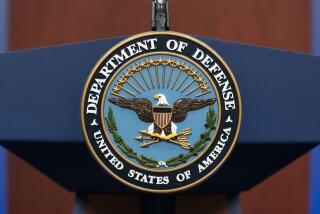Analysts See Escalation Risk in Bosnia Plan : Military: The initiative is more modest than what the U.S. had proposed. But things could turn sour if Serbs resist.
- Share via
WASHINGTON — The military mission that the United States has accepted under the new allied plan for Bosnia-Herzegovina is much more limited than the Clinton Administration initially proposed, but it still risks escalation if the Bosnian Serbs put up resistance, defense analysts said Sunday.
U.S. forces already have the aircraft, ships and ordnance on hand in the area to carry out the United States’ two major assignments under the plan--to provide air cover to protect U.N. peacekeeping forces in newly created safe areas and to evacuate the troops if they are pinned down.
Attack planes and fighters from the aircraft carrier Theodore Roosevelt already are flying combat air patrols to enforce the “no-fly” zone that the allies imposed over Bosnia earlier this year--with attack helicopters on the amphibious ship Saipan now standing by. And C-130 transports that have been flying from Europe to carry out humanitarian airdrops and to deliver relief supplies could also be redirected to evacuate U.N. forces if needed, analysts said.
The chief risk of escalation would come, however, if the Bosnian Serbs--or Croats, for that matter--managed to shoot down a plane with antiaircraft artillery or shoulder-fired missiles, as happened in the Persian Gulf War.
“What happens if things turn sour--do you launch additional air strikes?” asked Harry Summers, a former Army colonel who is an independent military analyst in the capital. “These are the kinds of questions they ought to be thinking about now--before it’s at hand.”
Several defense experts cautioned that with three major warring factions--and deeply rooted animosities--the potential for such incidents is greater than usual.
If U.S. aircraft have to fly at low altitudes to provide close air support for U.N. forces in the havens, they would be vulnerable to anti-aircraft fire and--in the case of the helicopters--small-arms fire as well. The British lost several planes that way in Iraq.
Summers also pointed out that for all the precision-guided weapons that U.S. forces now have, the technology works far better against stationary targets than it does against easy-to-move weaponry such as antiaircraft artillery or shoulder-fired missiles.
Jim Blackwell, military analyst for SAIC, a Washington-area research organization, said the risks would be greater if U.S. forces had to evacuate large numbers of U.N. troops, because the newly landed aircraft would be vulnerable to small arms and mortar attack. The U.N. force now numbers about 9,000 but would probably grow substantially to take over the expanded protection role.
Anthony H. Cordesman, another military analyst, said that such problems could be exacerbated by the fact that the opposing forces in Bosnia are not cleanly separated but are mixed together in the regions of proposed havens, making it easier for them to launch guerrilla attacks.
To be sure, U.S. strategists have some experience in enforcing safety zones. The United States provided the bulk of the military power for protecting the Kurdish population in northern Iraq. And U.S. troops successfully established secure zones recently in Somalia.
Still, Blackwell pointed out that in both cases, authorities were able to make use of U.S. ground forces whose effectiveness was heightened by the tough image that American forces earned in earlier phases of those operations.
The Administration already has said that it will not be sending U.S. ground troops into the fray in Bosnia.
More to Read
Sign up for Essential California
The most important California stories and recommendations in your inbox every morning.
You may occasionally receive promotional content from the Los Angeles Times.













